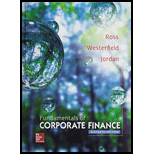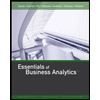
Fundamentals of Corporate Finance with Connect Access Card
11th Edition
ISBN: 9781259418952
Author: Stephen A. Ross Franco Modigliani Professor of Financial Economics Professor, Randolph W Westerfield Robert R. Dockson Deans Chair in Bus. Admin., Bradford D Jordan Professor
Publisher: McGraw-Hill Education
expand_more
expand_more
format_list_bulleted
Question
Chapter 13, Problem 3M
Summary Introduction
Case summary:
Person J recently joined an investment firm named Company CW. His boss, Person P was taking about the investment portfolio. Person P is concerned about the systematic risks of potential investments. The company wants to analyze one such potential investment namely, Company C.
A vendor provides data about the stocks. However, the vendor does not disclose the method of calculating the data. Person P wants to know the way in which the analysis is made. Hence, he asks Person J to evaluate Company C.
Characters in the case:
- Company CW: Investment firm
- Person P: Founder of Company CW
- Person J: New employee
- Company C: The potential investment
To perform: Regression analysis on the monthly returns of Company C and S and P 500 for 36 months and plot the variables in a graph.
Expert Solution & Answer
Want to see the full answer?
Check out a sample textbook solution
Students have asked these similar questions
Which of the following statements is true about the time value of money?
a) A dollar today is worth more than a dollar in the future due to inflation.b) A dollar today is worth more than a dollar in the future because of interest earning potential.c) A dollar today and a dollar in the future are worth the same.d) The time value of money is not affected by interest rates.
What is the formula for the Net Present Value (NPV) of a series of cash flows? explain
no ai..??
If a stock is priced at $50 and increases by 10%, what's its new price?
Chapter 13 Solutions
Fundamentals of Corporate Finance with Connect Access Card
Ch. 13.1 - How do we calculate the expected return on a...Ch. 13.1 - In words, how do we calculate the variance of the...Ch. 13.2 - What is a portfolio weight?Ch. 13.2 - How do we calculate the expected return on a...Ch. 13.2 - Is there a simple relationship between the...Ch. 13.3 - What are the two basic parts of a return?Ch. 13.3 - Under what conditions will a companys announcement...Ch. 13.4 - Prob. 13.4ACQCh. 13.4 - Prob. 13.4BCQCh. 13.5 - What happens to the standard deviation of return...
Ch. 13.5 - What is the principle of diversification?Ch. 13.5 - Why is some risk diversifiable? Why is some risk...Ch. 13.5 - Why cant systematic risk be diversified away?Ch. 13.6 - Prob. 13.6ACQCh. 13.6 - What does a beta coefficient measure?Ch. 13.6 - True or false: The expected return on a risky...Ch. 13.6 - How do you calculate a portfolio beta?Ch. 13.7 - Prob. 13.7ACQCh. 13.7 - What is the security market line? Why must all...Ch. 13.7 - Prob. 13.7CCQCh. 13.8 - If an investment has a positive NPV, would it plot...Ch. 13.8 - What is meant by the term cost of capital?Ch. 13 - Prob. 13.1CTFCh. 13 - Prob. 13.5CTFCh. 13 - Beta is a measure of what?Ch. 13 - The slope of the security market line is equal to...Ch. 13 - Where would a negative net present value project...Ch. 13 - Prob. 1CRCTCh. 13 - Prob. 2CRCTCh. 13 - Systematic versus Unsystematic Risk [LO3] Classify...Ch. 13 - Systematic versus Unsystematic Risk [LO3] Indicate...Ch. 13 - Prob. 5CRCTCh. 13 - Diversification [LO2] True or false: The most...Ch. 13 - Portfolio Risk [LO2] If a portfolio has a positive...Ch. 13 - Beta and CAPM[LO4] Is it possible that a risky...Ch. 13 - Corporate Downsizing [LO1] In recent years, it has...Ch. 13 - Earnings and Stock Returns [LO1] As indicated by a...Ch. 13 - Determining Portfolio Weights [LO1] What are the...Ch. 13 - Portfolio Expected Return [LO1] You own a...Ch. 13 - Portfolio Expected Return [LO1] You own a...Ch. 13 - Prob. 4QPCh. 13 - Prob. 5QPCh. 13 - Prob. 6QPCh. 13 - Calculating Returns and Standard Deviations [LO1]...Ch. 13 - Calculating Expected Returns [LO1] A portfolio is...Ch. 13 - Returns and Variances [LO1] Consider the following...Ch. 13 - Returns and Standard Deviations [LO1] Consider the...Ch. 13 - Calculating Portfolio Betas [LO4] You own a stock...Ch. 13 - Calculating Portfolio Betas [LO4] You own a...Ch. 13 - Using CAPM[LO4] A stock has a beta of 1.15, the...Ch. 13 - Using CAPM[LO4] A stock has an expected return of...Ch. 13 - Using CAPM [LO4] A stock has an expected return of...Ch. 13 - Using CAPM [LO4] A stock has an expected return of...Ch. 13 - Using the SML[LO4] Asset W has an expected return...Ch. 13 - Reward-to-Risk Ratios [LO4] Stock Y has a beta of...Ch. 13 - Reward-to-Risk Ratios [LO4] In the previous...Ch. 13 - Using CAPM [LO4] A stock has a beta of 1.14 and an...Ch. 13 - Portfolio Returns [LO2] Using information from the...Ch. 13 - Prob. 22QPCh. 13 - Portfolio Returns and Deviations [LO2] Consider...Ch. 13 - Analyzing a Portfolio [LO2, 4] You want to create...Ch. 13 - Analyzing a Portfolio [LO2, 4] You have 100,000 to...Ch. 13 - Systematic versus Unsystematic Risk [LO3] Consider...Ch. 13 - SML [LO4] Suppose you observe the following...Ch. 13 - SML [LO4] Suppose you observe the following...Ch. 13 - Prob. 1MCh. 13 - Beta is often estimated by linear regression. A...Ch. 13 - Prob. 3MCh. 13 - Prob. 4MCh. 13 - Prob. 5M
Knowledge Booster
Similar questions
- The required return on a stock is 10%, the stock's beta is 1.2, and the risk-free rate is 3%. Using the Capital Asset Pricing Model (CAPM), what is the expected return of the stock? a) 7.2%b) 10%c) 12%d) 15%step by step!!arrow_forwardWhat is the difference between cash and accrual accounting? No ai ..???arrow_forwardA savings account earns a 2% annual interest rate. If you deposit $1,000, how much interest will you earn in a year?arrow_forward
- A bond with a face value of $1,000 and an annual coupon rate of 5% pays $50 in interest each year. If the bond is priced at $950, what is its current yield? a) 4.74%b) 5.26%c) 5%d) 6% help!arrow_forwardA company's stock price rises from $20 to $25. What's the percentage increase?arrow_forwardThe required return on a stock is 10%, the stock's beta is 1.2, and the risk-free rate is 3%. Using the Capital Asset Pricing Model (CAPM), what is the expected return of the stock? a) 7.2%b) 10%c) 12%d) 15% explanationarrow_forward
- 7. A credit card charges 18% annual interest. If you have a $500 balance, what's the interest charged over a year?arrow_forwardIf a stock pays a $2 dividend per share and you own 100 shares, what's your total dividend income?arrow_forwardYou invest $2,000 in a mutual fund with a 7% annual return. How much will you have after one year?arrow_forward
- If a $1,000 investment grows to $1,100 in two years, what's the annual rate of return?arrow_forwardNo Ai A bond with a face value of $1,000 and an annual coupon rate of 5% pays $50 in interest each year. If the bond is priced at $950, what is its current yield? a) 4.74%b) 5.26%c) 5%d) 6%arrow_forwardQ: How do I diversify my investment portfolio?need a helparrow_forward
arrow_back_ios
SEE MORE QUESTIONS
arrow_forward_ios
Recommended textbooks for you
 Essentials of Business Analytics (MindTap Course ...StatisticsISBN:9781305627734Author:Jeffrey D. Camm, James J. Cochran, Michael J. Fry, Jeffrey W. Ohlmann, David R. AndersonPublisher:Cengage Learning
Essentials of Business Analytics (MindTap Course ...StatisticsISBN:9781305627734Author:Jeffrey D. Camm, James J. Cochran, Michael J. Fry, Jeffrey W. Ohlmann, David R. AndersonPublisher:Cengage Learning

Essentials of Business Analytics (MindTap Course ...
Statistics
ISBN:9781305627734
Author:Jeffrey D. Camm, James J. Cochran, Michael J. Fry, Jeffrey W. Ohlmann, David R. Anderson
Publisher:Cengage Learning